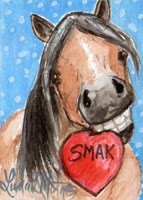Heck Tarpan Stallion in Spring
Why I will be painting a lot of these little historic restoration horses over the next few months. The purpose is to learn them.
 |
"Heck Tarpan Stallion in Spring"
9 by 12 inches
Watercolor |
When I was young I read a book about a groom and a thoroughbred race horse in Japan during the war. In the book in order to be a groom of racehorses, which was an honorable profession, one must learn many things and then one was assigned to a horse for its life time. Besides knowing basic horsemanship and basic grooming skills, in order to be assigned a horse one also had to be able to show proficiency in the bone structure, muscles etc. This was so you knew how to care for your horse and avoid injury and understand how muscles were connected so you could treat injury and illness.
I am simplifying it a bit. In the book the young man had to take a test before he was permanently assigned his horse. The test was to draw a horse from the skeleton, to the organs, to the muscles and then to the outer skin. I found it fascinating to read the description of it. When he could draw the horse completely from the inside out that would show that he really knew where things were.Also when asked how to treat injuries he would be able to show where the injury started and point out how to treat by the image he drew.
 |
"Heck Tarpan Stallion Study"
5 by 7 inches
Watercolor |
After his training the groom was assigned a beautiful chestnut mare with a wide blaze. When WW2 started all the horses were commandeered. The stallions and geldings were sent off to be war horses and the mares were assigned hard labor. This pair were assigned to the quarry where the mare had to pull a cart of heavy rocks to help repair roads and forts after bombings. Each night the groom would massage every inch of the mare's tired body, so that she did not become musclebound and unable to run again in races. That was the practical part of being a lover of a horse and a true horseman. As the story goes, because of his knowledge of what to do to preserve the mare's true purpose, after the war she went on to race again and become a winner.
Later in life I read of Rosa Bonheur and how as a young woman in the 1830s she dressed as a man and she would sneak into stockyards and slaughter houses to study and draw horses and cattle from the inside out. What she did was illegal because she was dressed as a man. But she seemed to do it with the complete knowledge of her artistic family and manged to surpass them all as well as most of the artists of the day in her skill and knowledge of painting horses. I have other reasons to admire her, including that she kept a complete zoo on her estate in France and was probably one of the first people since the Roman Empire to breed big cats, lions included, on her estate/farm in France successfully.
 |
| Detail Heck Tarpan Stallion in Spring |
So I am saying all of this because, whether an artist is painting from life, from memory or from photographs, they still have to know what is under the skin of a horse( or any animal) and how to recognize what they are seeing before they can really really paint the spirit of the animal. That takes some talent, some imagination, but most of all that takes skill that comes from a lot of hours and years of practice.
One of my favorite quotes of Rosa Bonheur is " If you can not paint your subject from memory, then you have not spent enough time preparing to paint by sketching it from life."
I am, after nearly50 years of drawing, and painting, and sometimes sculpting horses, still practicing.
Don't miss Signing up for the
LLMartin Artistic Services Newsletter
email me at: info@llmartin.com
LindaLMartin©2015
All North and South American World and Electronic Rights Reserved.



































